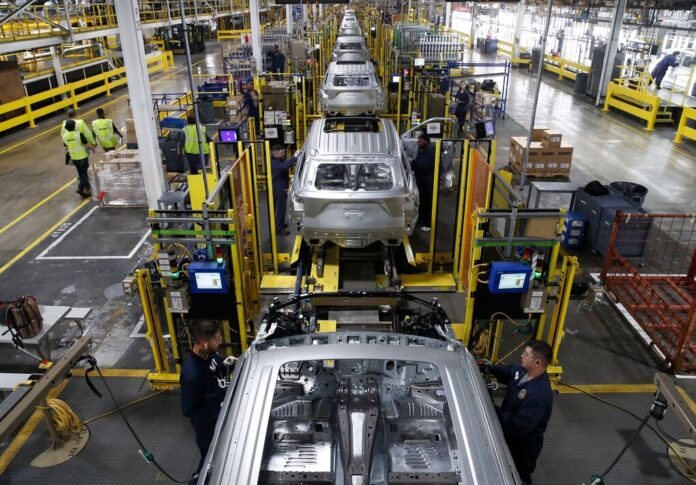The Optimistic Outlook for US Growth, Spending, and Employment
The optimistic outlook for US growth, spending, and employment reflects the ongoing recovery from the COVID-19 pandemic. Economists are buoyed by the strong rebound in consumer spending, supported by robust job gains and increased vaccination rates. As businesses continue to reopen and restrictions are lifted, economic activity is expected to accelerate further, driving GDP growth to new heights.
Inflationary Pressures and the Need for a Cautious Approach
However, amidst this positive economic outlook, economists are also closely monitoring inflationary pressures. Recent data has shown a surge in prices across various sectors, fueled by supply chain disruptions, pent-up demand, and fiscal stimulus measures. As a result, economists now anticipate that inflation will remain elevated for a longer period, necessitating a more cautious approach by the Federal Reserve in terms of interest rate policy.
The Revised Forecasts and the Gradual Approach to Normalizing Monetary Policy
The upward revision in interest rate forecasts reflects the belief that the Federal Reserve will need to take a more gradual and measured approach to normalizing monetary policy. The central bank has emphasized its commitment to achieving maximum employment and price stability, and the persistent above-target inflation has raised concerns about the potential risks to the economy.
The Eventual Tightening of Monetary Policy and Higher Interest Rates
While economists expect the Federal Reserve to maintain its accommodative stance in the near term, they anticipate that the central bank will eventually need to start tightening monetary policy to curb inflationary pressures. The projected reduction in the upper boundary of the target range for the benchmark interest rate to 4% by the end of 2025 suggests that interest rates will remain relatively high compared to historical levels.
The Prudent and Data-Dependent Approach by the Federal Reserve
Furthermore, the median projection of only two quarter-point cuts in interest rates this year indicates a more cautious approach by the Federal Reserve. This suggests that policymakers will carefully assess the evolving economic conditions and inflation dynamics before making any significant adjustments to interest rates.
The Impact of Government Policies and Initiatives on Forecasts
Additionally, the revised forecasts for US growth, spending, and employment take into account the potential impact of government policies and initiatives. The current administration’s focus on infrastructure development, tax reforms, and deregulation is expected to have a positive effect on the economy.
Infrastructure Development and its Effects on Jobs and Economic Activity
Infrastructure investments, such as the proposed upgrades to roads, bridges, and public transportation systems, are expected to create jobs and stimulate economic activity. These projects will not only improve the country’s infrastructure but also provide employment opportunities for construction workers and boost demand for materials and equipment.
The Impact of Tax Reforms on Business Investment and Economic Growth
The tax reforms implemented by the government are also expected to have a significant impact on the economy. Lower corporate tax rates and simplified tax codes are anticipated to incentivize business investment and expansion. This, in turn, is likely to lead to increased productivity, job creation, and overall economic growth.
The Stimulating Effects of Deregulation on Economic Activity
In addition to infrastructure development and tax reforms, the government’s efforts to deregulate certain industries are expected to stimulate economic activity. By reducing regulatory burdens and streamlining processes, businesses may find it easier to operate, innovate, and invest. This could result in increased competition, lower prices for consumers, and improved efficiency in various sectors of the economy.
The Need for a Prudent and Data-Dependent Approach by the Federal Reserve
Overall, the revised forecasts for US growth, spending, and employment reflect a positive outlook for the country’s economy. With factors such as increased business investment, higher consumer spending, improved global economic conditions, and government policies supporting growth, the US is poised to experience a period of economic expansion and job creation in the coming years.
The Impact of Higher Interest Rates on the Economy
Additionally, higher interest rates can have an impact on the overall economy. As borrowing costs increase, businesses may find it more expensive to finance their operations and expansion plans. This could potentially lead to a decrease in business investment, which in turn can slow down economic growth.
The Implications for the Government’s Fiscal Policy
Furthermore, the decision to keep interest rates higher for longer may also have implications for the government’s fiscal policy. Higher interest rates mean that the cost of borrowing for the government will increase, potentially putting pressure on the budget deficit. This could require the government to make difficult decisions regarding spending and taxation in order to maintain fiscal stability.
The Impact on Emerging Markets
Another factor to consider is the impact of higher interest rates on emerging markets. As the US dollar strengthens due to higher interest rates, it can put pressure on currencies of emerging market economies. This can make it more expensive for these countries to service their dollar-denominated debts, leading to potential financial instability.
Weighing the Benefits and Drawbacks of Higher Interest Rates
It is worth noting that the decision to keep interest rates higher for longer is not without risks. While it aims to control inflation and ensure long-term stability, it can also potentially slow down economic growth and impact various sectors of the economy. Therefore, policymakers will need to carefully weigh the benefits and drawbacks of this approach in order to strike the right balance.

